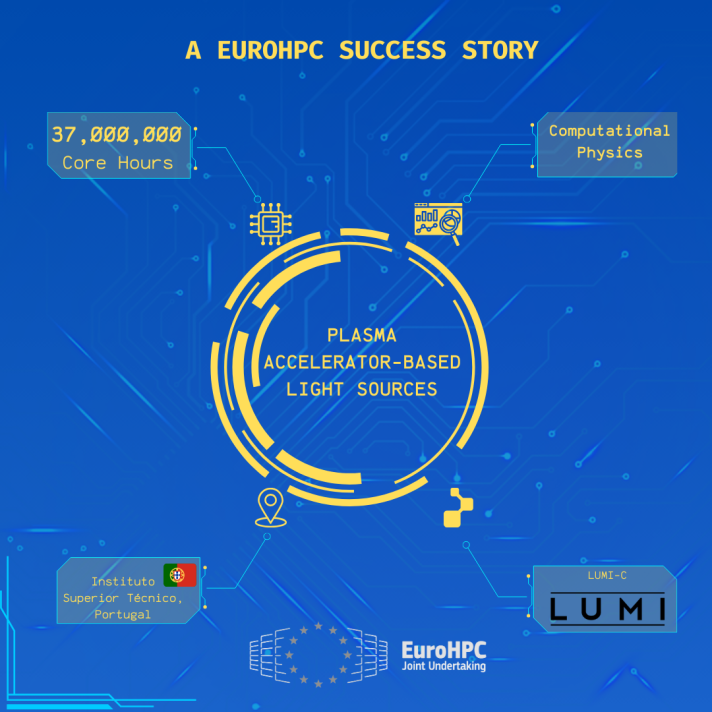Context and project goals
In the pursuit of generating exceptionally bright light to inspect matter such as viruses at nano scale, scientists frequently rely on electron beams, travelling close to the speed of light.
The traditional approach to produce such ultra-energetic electron beams usually depends on multi-kilometres long particle accelerators. Miniaturizing these large-scale devices would be a revolutionary leap and HPC resources can help achieve this.
This project sets out to answer pivotal questions: Can we miniaturise these light sources to fit them into university-scale laboratories? Can plasma accelerator-based light sources shine as brightly as most advanced light sources, like free electron lasers?
Plasma may hold the answer.
Plasma is a “soup” of charged particles, often referred to as the ‘the fourth state of matter’ alongside solids, liquids and gases. Its behaviour is of critical interest to scientists across a range of disciplines, as it can withstand electric fields.
By leveraging on this unique feature, the project aims at redefining collective electron motions and develop a novel light source that can be simultaneously bright and compact, known as quasi-particle.
To illustrate this, the team drew an analogy to the phenomenon of Mexican waves, using EuroHPC supercomputers. These are wave-like movements made by a crowd watching a sports game in a stadium, where the wave seemingly circumnavigates the arena while each individual in the crowd remains stationary.
In a similar way, the collective electron wave could surpass the speed of any individual electron. The consequences, however, are more profound. These electron waves could potentially exceed the speed of light, imitating gravitational forces, and radiate as singular super-luminal electrons subjected to unimaginably high forces.
Research Team
A dedicated team of four researchers from the Group of Lasers and Plasmas (GoLP), at the University of Lisbon and from the Instituto Superior Técnico (IST) collaborated with six international researchers. They formed a collective of ten experts that studied the intricate complexities of plasma accelerators, pushing the boundaries of scientific exploration in this field.
Computational Methods
Employing the Osiris particle-in-cell (PIC) code, developed in collaboration with the University of California - Los Angeles (UCLA), the team simulated plasma dynamics with an unparalleled precision. The Radiation Diagnostic for Osiris (RaDiO) played a key role in the analysis of radiation properties.
As standard analytical models cannot provide precise experiments’ results, the use of HPC is the ideal research tool. In fact, leveraging the EuroHPC supercomputing resources became indispensable for handling the computational intensity inherent to their work.
Project Timeline
While adhering to the initial timeline, the team embraced unforeseen challenges and priorities that enriched their understanding, enhancing the depth of their research.
Potential Impact
Light sources greatly impact our lives.
For example, they play a crucial role in non-destructive imaging (like scanning for viruses or checking product quality), understanding biological processes (like photosynthesis), manufacturing computer chips and exploring the behaviour of matter in planets and stars.
If successfully built and experimentally demonstrated, compact light sources could foster technological advancement and become accessible in universities, hospitals and industrial laboratories.
Achievements Leveraging EuroHPC Supercomputers and Future Utilisation
Leveraging EuroHPC supercomputers, as well as the Osiris particle-in-cell (PIC) code, provided parallel efficiencies exceeding 90%, acting as virtual laboratories and offering critical insights to the research. The computational power provided by EuroHPC resources accelerated the experimentation process, serving as a unique basis for groundbreaking discoveries.
Continued access to EuroHPC resources remains pivotal for the ongoing project. As the team envisions future endeavours in the same area, EuroHPC supercomputers will play a key role, propelling research and revolutionising the landscape of plasma accelerator-based light sources.
